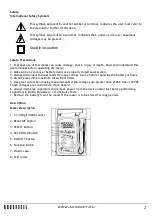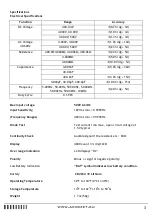
4
Size
4.25x2.2x.5” (108x56x11.5mm)
Standard
IEC1010 CAT II 500V Pollution degree II,
CE Approved
Operation
AC or DC Voltage Measurement
1.
Set the function switch to the “
DCV
” position for DC voltage measurements, or “
ACV
” position
for AC voltage measurements.
2.
Touch the test probe tips to the circuit under test. Be sure to observe the correct polarity
(red lead to positive, black lead to negative).
3.
Read the voltage on the display
Resistance/Continuity Measurement
WARNING
: To avoid electric shock, disconnect power to the unit under test and discharge all
capacitors before taking any resistance measurements. Remove the batteries and unplug the
line cords. Never measure continuity on circuits or wires that have voltage on them.
1.
Set the function switch to the “ Ω •))) ” position.
2.
Connect the test leads to the circuit to be measured.
3.
Read the value on the display.
4.
For Continuity tests, press the SELECT button until the “•)))“ symbol appears in the display.
5.
If the resistance is less than 60 ohms, an audible tone will sound.
Capacitance Measurement
WARNING:
To avoid electric shock, disconnect power to the unit under test and discharge all
capacitors before taking any capacitance measurements. Remove the batteries and unplug the
line cords. Never measure continuity on circuits or wires that have voltage on them.
1.
Set the function switch to the “ Ω •))) ” position.
2.
Press the SELECT button until “nF” appears in the display.
3.
Press the RELATIVE button to zero the display
4.
Connect the test leads to the capacitor to be measured.
5.
Read the value on the display.
Diode Test
WARNING
: To avoid electric shock, do not test any diode that has voltage on it.
1.
Set the function switch to “ Ω •))) “position.
2.
Press the SELECT button once to enter Diode Test. The “ “ symbol will appear in the display.
3.
Touch the test probe tips to the diode or semiconductor junction you wish to test. Note the
meter reading.
4.
Reverse the test lead polarity by reversing the red and black leads. Note this reading.
5.
The diode or junction can be evaluated as follows:
A.
If one reading shows a value and the other reading shows OL, the diode is good.
B.
If both readings show OL, the device is open.
C.
If both readings are very small, or 0, the device is shorted
Frequency/Duty Cycle Measurement
1.
Set the function switch to the “
HZ/DUTY”
position.





